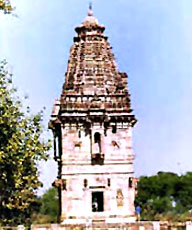 The Mahamaya Devi Mandir is located along the Bilaspur-Ambikapur State Highway, just 25 km from the Bilaspur town. This 12th century temple has been built in the Nagara style of temple architecture. It enshrines an amazing dual statue of Goddess Mahamaya Devi-the front image of `Mahishasuramardini` and the rear statue of Goddess Saraswati.
The Mahamaya Devi Mandir is located along the Bilaspur-Ambikapur State Highway, just 25 km from the Bilaspur town. This 12th century temple has been built in the Nagara style of temple architecture. It enshrines an amazing dual statue of Goddess Mahamaya Devi-the front image of `Mahishasuramardini` and the rear statue of Goddess Saraswati.
Supported by 16 columns. Mahamaya Devi temple is surrounded by an 18-inch thick perimeter wall. Most of the statues and motifs used in the temple have been taken from the remnants of certain ancient temples; some of them were also Jain temples. The main complex of the temple has other smaller statues of Goddess Kali, Bhadrakali, Surya, Lord Vishnu, Lord Hanuman, Bhairav and Lord Shiva. It is said that the first puja and `avishek` (holy, ritualistic bathing of an idol) of the Devi was performed by Kalinga King Ratna Dev in 1050 AD. A popular belief among the devotees is that, one should visit the Kaal Bhairav Mandir before visiting the Goddess Mahamaya Devi as Kaal Bhairav is regarded as the doorkeeper of the Devi. The Navratri festival celebrated here is a major tourist draw attended by several thousands of the faithful from far and near.





















